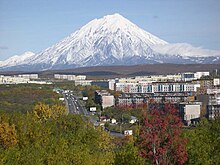Eastern Siberia
With Eastern Siberia , the usually very is mountainous eastern third of Siberia called.
It extends - north and south of the Arctic Circle - from the Lena over the East Siberian highlands and the relatively small East Siberian lowlands to the Chukchi Peninsula . The latter extends to Cape Deschnjow on the Bering Strait , which separates Asia from North America .
In the north (from the Lena estuary to the Bering Strait), Eastern Siberia borders the Laptev Sea , the East Siberian Sea and the Chukchi Sea , each of which is part of the icy Arctic Ocean . In the east it borders on the Bering Sea , as well as in the southeast, if the huge peninsula of Kamchatka - the "peninsula of volcanoes " - is included in Siberia. The southern coast of Eastern Siberia forms the Sea of Okhotsk , which is an isolated marginal sea of the Pacific .
The southern regions of the " Russian Far East " between the Amur , Vladivostok and the island of Sakhalin no longer belong to Siberia.
East Siberia essentially coincides with the East Siberian mountainous region . Many small, including Mongolian minorities live in this sparsely populated area, some of whose districts have been given a certain degree of autonomy . In administrative terms, by far the largest area is in the Republic of Yakutia (Sakha), while the Magadan Oblast and the autonomous districts of the Chukchi and Koryaks together make up about 30%.
The largest cities in Eastern Siberia are Yakutsk , Petropavlovsk-Kamchatsky and Magadan . None of them have more than 300,000 inhabitants.
See also
literature
- A. Gorkin and others: Geografija Rossii: Enziklopeditscheski slowar . Bolschaja Rossijskaja enziklopedija, Moscow 1997, ISBN 5-85270-276-5 , p. 130. (Russian)
Web links
- Entry in the North encyclopedia (English / Russian)


